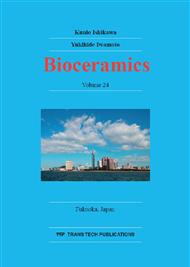p.143
p.147
p.153
p.157
p.161
p.167
p.173
p.178
p.183
Adsorption Behavior of Sodium Inositol Hexaphosphate on the Surface of Hydroxyapatite
Abstract:
We have previously developed hydroxyapatite (HAp) cement based on the chelate-setting mechanism of sodium inositol hexaphosphate (IP6), in which HAp powder was prepared by surface-modification with IP6 after ball-milling of the HAp powder (conventional process). Meanwhile, we have recently established novel powder preparation process (modified process). In the present study, the adsorption behavior of IP6 on the surface of HAp at both the processes was circumstantially examined to clarify the chelating mechanism of IP6. The adsorbed amount of IP6 increased with the IP6 concentration in both the processes; however, the adsorbed amount of IP6 at the modified process was lower than that at the conventional process. X-ray photoelectron spectroscopic study revealed that the IP6 adsorbed on the surface of HAp powders. The degree in dispersion of the HAp particles at the modified process was higher than that at conventional process. Furthermore, the elution of IP6 from the powders prepared at the novel process was lower than that of the powders at the conventional process.
Info:
Periodical:
Pages:
161-166
Citation:
Online since:
November 2012
Authors:
Price:
Сopyright:
© 2013 Trans Tech Publications Ltd. All Rights Reserved
Share:
Citation:


